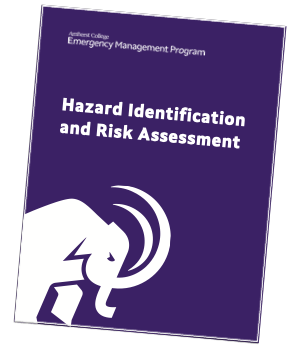
Process
A preliminary list of natural, technological (accidental) and human-caused (intentional) hazards was developed from stakeholder input, existing College planning documents, and local and state risk assessments. Relevant data for each of the hazards were requested from College departments, local, state, and federal government agencies, and private sector partners. The data informed a series of interviews with subject matter experts from the College and the Town of Amherst to elicit additional information or gain clarification. Using the collected data and stakeholder input, the nature and approximate risk of each hazard was assessed to arrive at a final set of hazards for inclusion in this report.
The methodology used to conduct the risk assessment is an enhanced version of the Priority Risk Index (PRI) that was tailored to better reflect the College’s values. The collected data were used to determine the probability (30%), impact (30%), spatial extent (20%), warning time (10%), and duration (10%) of a reasonable realization of each hazard. These weighted values were then used to calculate a quantitative Risk Index and a qualitative Relative Risk Category of Low, Moderate, or High.
Mitigation Considerations
Only those mitigation measures that result in a permanent and consistent reduction in risk (e.g., backup power generation, fire protection systems, vaccination requirements) were considered. A higher-than-expected Relative Risk Category does not necessarily indicate that a hazard is not being mitigated effectively. Instead, it may provide additional justification for sustained resource allocation.
Hazard Profiles
A profile of each hazard contains a detailed description, notable historical occurrences affecting the College or region, a fictional but realistic account of how the hazard could affect the College, and commentary on the data that form the basis of the risk calculation. Selected profiles also include information on the potential for climate change to affect the future probability and impact of the hazard.
How This Report Will Be Used
The results of this assessment will help prioritize and justify risk reduction activities identified in the College’s Hazard Mitigation Plan (to-be-developed). The detailed hazard profiles contain useful data for operational planning, exercise development, and community outreach.